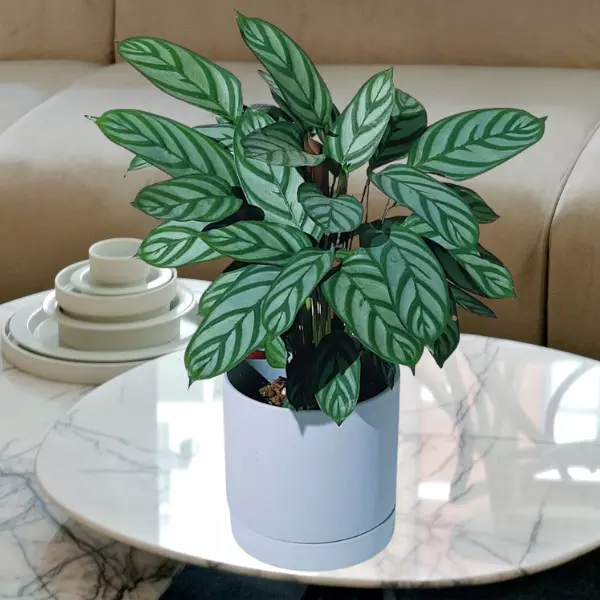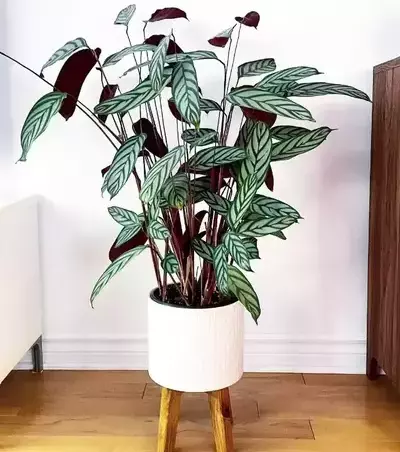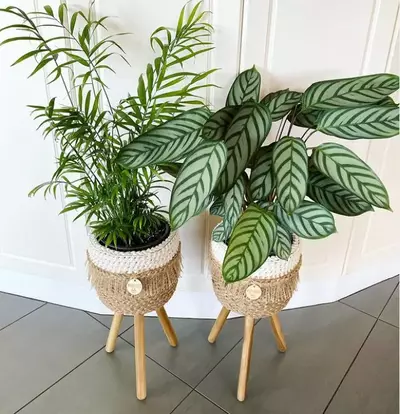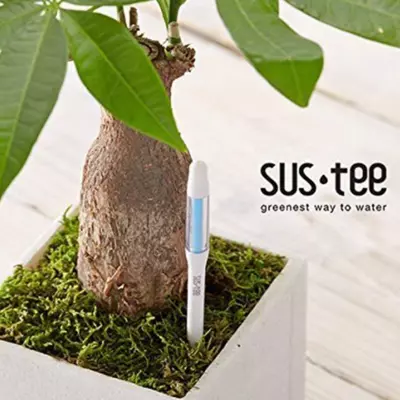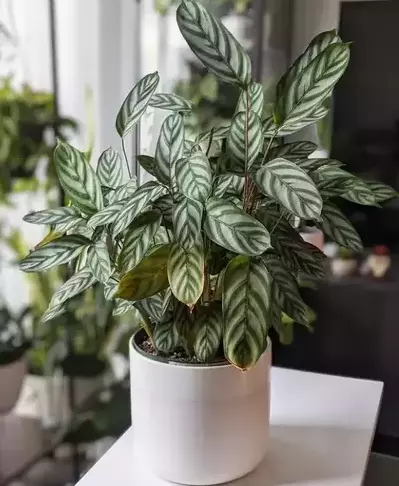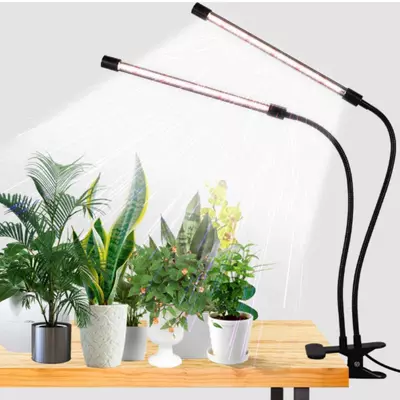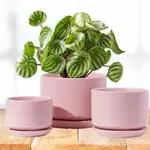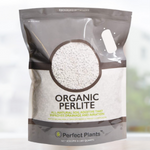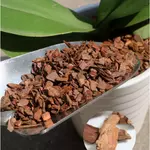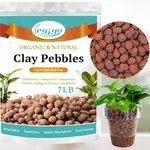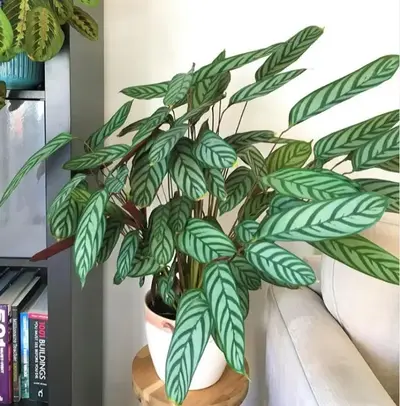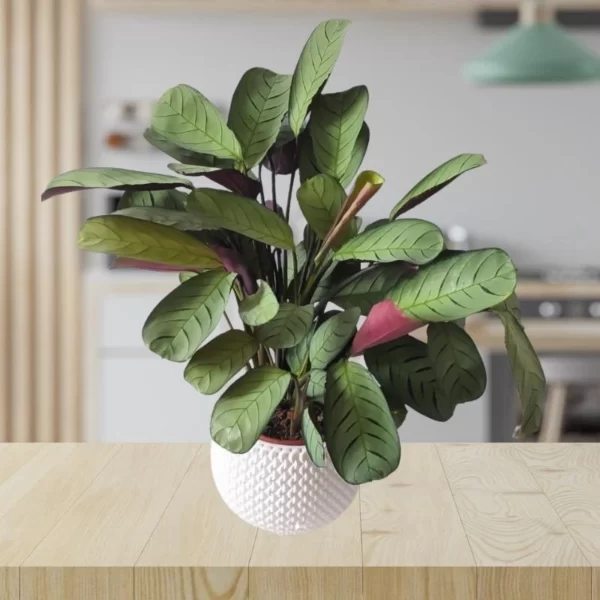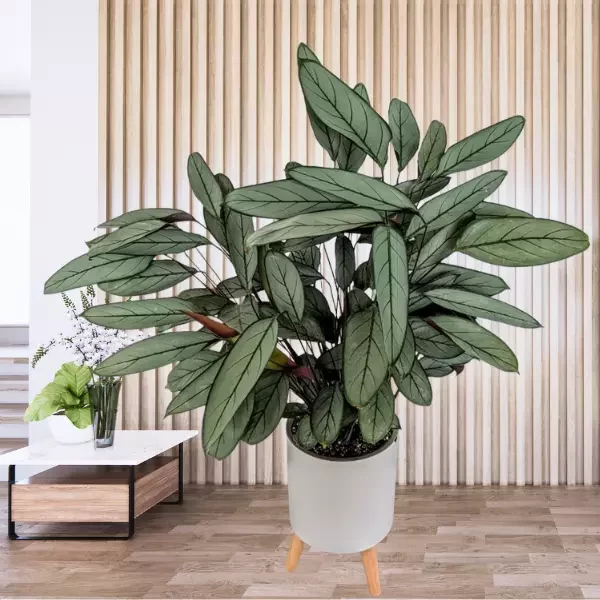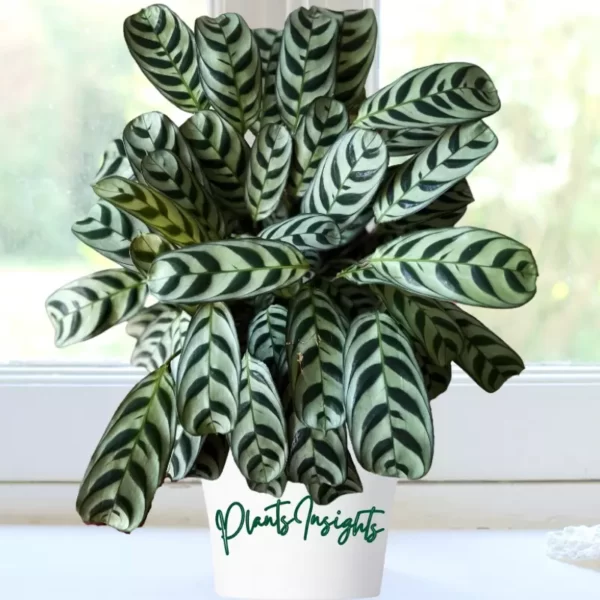Ctenanthe Setosa Compact Star is a splendid clump-forming house plant exhibiting long striped, lush green, and striking variegated foliage. The distinctive Setosa Compact Star, also known as the Never-Never plant, is native to Brazil and an eye-catching member of the Marantaceae or arrowroot family. However, interestingly you would find this evergreen plant around the world with many trade names such as “Ctenanthe Setosa”, Calathea Compact Star”, “Calathea Setosa” or “Never-Never plant”.
It is worth mentioning that the Ctenanthe genus also belongs to prayer plants like Calatheas, Stromanthe, and Marantas because of their leaf movement. They all fold their leaves at night and unfurl them during the days. The distinctively patterned leaves of Ctenanthe are very similar to Calatheas; however, they are easy to care for and are not drama queens like many Calatheas. In addition, Ctenanthe Setosa foliage looks similar to Calatheas, and they often get mislabeled as Calatheas which is a different genus of prayer plants. Moreover Ctenanthe Setosa is also mistaken for Ctenanthe Oppenheimiana and Ctenanthe Amabilis which are almost identical to Setosa but Oppenheimiana is taller with larger leaves compared to Setosa, whereas Amabilis is smallest of all.
The Ctenanthe genus was introduced in 1884, and the name, Ctenanthe, is a Greek word “ktenos,” meaning “comb,” and anthera meaning “anther.” Plus the word Setosa in Ctenanthe Setosa Compact Star name refers to the hairy leaf stems or petioles.
Allied Species: Ctenanthe Lubbersiana, Ctenanthe Burle-Marxii, Ctenanthe Setosa Grey Star, Ctenanthe Oppenheimiana, Ctenanthe Marantifolia, Ctenanthe Setosa
Habitat & Ecology of Calathea Setosa
| Botanical Name: | Ctenanthe Setosa |
| Family Name: | Marantaceae |
| Common names: | Ctenanthe Setosa Compact Star, Never Never plant, Calathea Setosa |
| Plant type: | Tropical perennial plant |
| Origin: | Rainforests of Brazil |
| Height: | 2-3 Feet |
| Humidity: | (50%-60%) |
| Temperature: | 55-85°F |
| Light Requirements: | Medium to Bright, indirect light |
| Soil Type | Moist , Well draining soil |
| Growth Habit: | Rhizomes, Upright |
| Flower | White insignificant blooms |
| Toxicity: | Kids and pets safe |
| USDA Hardiness zone: | USDA zones 9 to 12. |

Growth
Ctenanthe Setosa or Calathea Compact star is a relatively fast-growing tropical herbaceous perennial growing around three feet or one meter tall. When grown indoors, it exhibits large, Elliptical, thick grayish-green colored leaves contrasting dark green geometric patterned venation and outlines. Moreover, the dark band or veins extends into the margin, and the pattern resembles a wheat tuft. The burgundy or deep purple undersides and long, sheathing petiole enhance the charm of this nature’s bounty, making it a showstopper wherever it is placed.
Is Ctenanthe Setosa an indoor plant?
Setosa Compact star Can be grown indoors and outdoors in warm, sheltered, shady locations. Ctenanthe Setosa is a low-growing plant that blooms white, small, and fleshy flowers seldomly. Moreover, when grown outdoor the plant foliage is bit faded compared to fresh green indoor leaves colour.
How do you care for Ctenanthe Setosa?
Ctenanthe Setosa plant is relatively easy to care for and makes a great addition to any indoor space. It does best in indirect sunlight, warm and humid conditions. Though it is not difficult to care for, there are a few things to keep in mind to ensure your plant stays healthy and happy. In this guide, we’ll cover everything you need to know about Calathea Compact star care, from watering to fertilizing to repotting. With a little love and attention, your never-never plant will thrive for years to come!

Bringing Ctenanthe Compact Star Home
When you first bring Ctenanthe Setosa into your home, there are a few initial care requirements to keep in mind. The plant may experience some stress in its new environment, so it’s important to keep an eye on it. Here are a few tips to help you get started:
By following these simple tips, you can help your Ctenanthe Compact Star thrive in its new home.

How Often to Water Calathea Setosa?
Ctenanthe Setosa prefers moist, well-drained soil and should be watered regularly during the growing season. Please remember the watering frequency will depend on the amount of light and heat the plant receives and the type of potting mix used. During the Winter, the plant is dormant; therefore, we recommend reducing the watering frequency.
Overwatering can be problematic with Ctenanthe, especially if the potting mix is not well-drained. Setosa does not like to sit in soggy soil; the plant may suffer from root rot, and leaves will start yellowing and drop off if it is overwatered. The best way to water Ctenanthe Setosa is to allow the upper two inches of the soil to dry out before watering. Watering them once in two weeks or once a week is enough, but the best strategy is to check the soil using your fingers, so if you feel that the soil has dried up to a knuckle, water your plant. Drench the soil to soak the root ball thoroughly, allowing moisture to reach the roots. The pots must have proper drainage so that no water stays in them. Empty the water drips regularly.
Pro Tip
Do not use cold or hard water. Please use room temperature distilled water for your plants.
Underwatering
This plant is not tolerant of drought conditions and does not like to dry out completely between watering. Underwatering can cause wilting of plant leaves, and they will turn crispy. If you notice these signs, please give your plant a good drink of water, and it will perk back up. It is essential to ensure that this plant gets enough water during the growing season, as it will need extra moisture to produce new leaves and stems.
This plant is not tolerant of cold water and will start to drop its leaves if it is watered with too cold water. Moreover, inconsistent watering may cause the crispiness of leaves.

Light requirements of Calathea Compact Star
Although Ctenanthe Setosa can tolerate kind of moderate brightness to low light but thrives best in bright, indirect sunlight. They’re used to that forest canopy of the jungles in brazil, so they will not tolerate any kind of the direct sun, which can burn its stunning leaves.
Please place it in an east or north-facing window where it can receive optimal sunlight to help your plant thrive. Dappled or diffused sunlight works best for this plant. We recommend using grow lights if you don’t have a bright spot in your home. Please make sure to give the plant at least 6 hours of light daily.
If you notice the leaves start drooping, it’s not getting enough light. Move it to a spot with more light, and let it adjust before moving it again. On the other hand, if you notice leaves turning yellow or brown, it’s getting too much light. Move it to a spot with less light or place it a few feet away from the window. Moreover, intense light causes fading of foliage colour. You will most likely notice Setosa grown outside has faded coloured leaves compared to leaves of a plant grown indoors.

Humidity and Temperature
Being a tropical plant of the rainforests of Brazil, your Never Never Plant enjoys a warm and humid climate. So giving them a moderate to high humidity level will be perfect for these guys. If the air is too dry, the leaves of the Ctenanthe Setosa will begin to curl up, and the tips of the leaves will turn brown and crispy.
The ideal humidity for Ctenanthe Setosa is 60% or higher, but it can tolerate moderate humidity levels between 50% and 60%. However, these levels are a bit high for a typical household unless you live in tropical regions such as Central or South America or Southeast Asia, where the average humidity is between 50% and 60%.
To raise the humidity level around your plant, you can mist it regularly, use a humidifier, or put it on a pebble tray. Moreover, grouping your plant also helps elevate the humidity level around the plants.
Setosa likes a warm, consistent environment, and ideal temperatures are between 18-24 degrees Celsius (64-75 degrees Fahrenheit). The plant does not tolerate temperatures below 60 degrees Fahrenheit; therefore, bring it inside during the frosty season. The plant will also suffer if exposed to low or high temperatures, sudden temperature changes, or droughts; the leaves curl up to protect themselves.
If the temperature drops too low, you can move your plant to a warmer location or use a heat mat. Keep the plant away from vents, cold drafts and air conditioners to prevent stressing your plant. And if the temperature rises too high, ensure plenty of ventilation and shade.
I highly recommend getting a hygrometer to monitor any changes in room temperature and humidity you will stay on top of things.

Soil Requirement
Ctenanthe Setosa Compact star requires a soil mix that is moist, well-draining and contains organic matter. The ideal pH level for Ctenanthe Compact star is between 6.0 and 7.0. To make your own soil mix, you will need the following ingredients:
- 50% Potting soil ( including peat)
- 20% Orchid bark
- 20% Perlite
- 10% Horticultural charcoal
- Worm Castings
The above ingredient will make the soil moist, chunky and nutrient-rich. Once you have combined the ingredients, wet the mix thoroughly and allow it to drain before planting your Setosa.
If you are not interested in making your soil mix, many ready-made options are available at your local garden centre or online. Be sure to choose a mix labelled as well-draining and rich in organic matter. Alternatively, these are some really good ready-made potting mixes for Setosa Compact star;
Recommended Products

Repotting of Ctenanthe Setosa
Ctenanthe Setosa is an attractive foliage plant spreading along the horizontal plane by shooting offsets that can fill the pot. If you don’t want to repot your Never Never Plant, you can pull out the offshoots and plant them in separate containers. However, for your Ctenanthe to enjoy the full swing, it is important to repot Setosa every 12-18 months or when the plant becomes root bound.
Root bound occurs when the plant’s roots have filled the pot and begin to circle around the inside. You may notice roots peeking through the drainage holes, and another sign is that the soil doesn’t hold the moisture for long. Follow the step by step guide;

Propagation of Ctenanthe Setosa
If you’re looking to add more of this gorgeous plant to your collection, read on for a step-by-step guide to each propagation method.
Propagating Ctenanthe Setosa by Division
Ctenanthe Setosa is a rhizomatous plant that can easily be propagated using the offsets that develop into bushy clumps around the base of the plant. When your Ctenanthe Amabilis matures, it gives the offshoots that can be separated from the main plant. For offset division, follow the step-by-step guide.
Pro Tip
When propagating, using the same type of soil used for an original plant is vital.
Propagating Never Never Plant in water
One of the easiest ways to propagate Compact Star is in water. Simply take a stem cutting that includes a node and a few leaves, and place it in a jar or glass of water. Change the water after a few days regularly. Within a few weeks, you would notice new roots developing. Once the roots are about half an inch or an inch long., you can put your cutting in the soil.
Propagating Ctenanthe Compact Star in soil
If you prefer, you can also propagate your Ctenanthe Setosa cuttings directly in the soil. Fill a small pot with a well-draining potting mix, and make a hole in the centre with your finger. Gently insert the cutting into the hole and pat the soil around it. Water well, and place the pot in a warm, bright spot. Keep the soil moist but not soggy, and you should see new growth beginning to appear within a few weeks.
Pro Tip
You can also use soilless mediums such as LECA to root the cuttings.
With these easy propagation methods, you’ll be able to grow as many Ctenanthe Setosa plants as you like!

Fertilizering
Never Never plant appreciates fertilizing once in a while during the Spring and Summer seasons. You can fertilize them with a diluted houseplant fertilizer to boost the growth of Ctenanthe since it contains iron for better development. Moreover, you can also use a seaweed solution by adding three ml of seaweed solution to one liter of water to fertilize your plant once a month. Using slow-release granular fertilizer also encourages new healthy foliage growth of your plant.
Pro Tip
Water your plant before feeding them fertilizer to prevent root damage. Be careful not to over-fertilize the plant as this can result in leaf burn. Applying fertilizers in the Winter can cause your plants to have damaged roots because the plant is dormant.

Is Ctenanthe Setosa toxic?
Ctenanthe Setosa is not toxic to humans or animals. However, it is important to keep this plant away from children and pets, as the leaves can cause skin irritation. If ingested, this plant can cause stomach upset. If you suspect that your child or pet has ingested this plant, please contact your local poison control center.

Pests and Common Problems
Ctenanthe Setosa is generally a low-maintenance plan, but a few pests, diseases, and common problems can affect it.
Pests:
Some of the most common pests that may attack Ctenanthe Setosa are mealybugs, spider mites, and grey mold.
Mealybugs are small, white, wingless insects that suck the sap out of plants. They can cause yellowing of the leaves and stunted growth. Mealybugs are usually found around the stems and leaves of the plant. Symptoms of mealybug attack include white wax over the leaves and black mold.
Please regularly inspect the underside of the leaves for any pests. You can try horticultural oil or insecticidal soap to get rid of mealybugs. Apply the oil or soap to the affected areas of the plant, being sure to coat all sides of the leaves and stems. You may need to apply the treatment a few times to eliminate the mealybugs.
Alternatively, take a cotton swab dipped in 70% isopropyl alcohol and swipe it directly on the mealy bugs.
Spider mites are also sap-sucking insects that cause yellowing of leaves with dark spots. To get rid of all these pests, add 3 ml of shampoo or dishwashing soap to one liter of water. Spray the mixture thoroughly on the foliage. Please ensure spraying the undersides of leaves, petioles, and every nook and corner of your plant during the evening. Later wash off your plant in the morning to let the plant photosynthesize effectively.
You can spray Captain Jack’s Dead Bug Brew on the leaves, use an old makeup brush, and paint it on the leaves to completely cover them. It really worked for my prayer plants. Moreover, applying the Neem oil to the foliage helps eliminate spider mites. Plus, showering your plant leaves with a water hose is always effective in removing pests.
Diseases:
Ctenanthe Setosa is susceptible to a few diseases, the most common of which is root rot. Root rot is caused by too much moisture around the plant’s roots. Poor drainage or frequent plant watering can cause water logging, leading to root rot as the roots suffocate. The roots will start to decay, and the plant will eventually die.
To prevent root rot, make sure the plant is in well-draining soil and that the pot has drainage holes. If you notice the leaves of the plant turning yellow or wilting, this is a sign that the plant is dehydrated. Water the plant deeply but allow the soil to dry out between waterings.
Common problems:
Unlike Calatheas, Setosa compact star is not a fussy plant and can tolerate temperature and other variation however may encounter a few problems.
Leaf Droping
One of the most common problems with Ctenanthe Setosa is leaf drop. Leaf drop can be caused by several factors, including too much or too little water, pests, diseases, or even stress. If you notice the leaves of your plant turning yellow and dropping off, check for any of the above problems and take corrective action.
Leaf Curling
Exposure to hot direct sunlight or high temperatures can cause the leaves to curl up. Moreover, the lack of humidity or dry air causes the leaves to curl. If it gets worse, the edges of leaves turn brown, exhibiting symptoms of sun scorch or environmental shock.

FAQs
What is Calathea Compact Star?
Calathea Compact Star is desired for its ornamental foliage and is mainly grown indoors by many plant lovers but can be grown outdoors as ground covers. However, Calathea Compact Star is a trading name or mistakenly spoken name for Ctenanthe Setosa compact star. Many sellers call Ctenanthe Setosa as Calathea Compact star due to their resemblance with Calatheas, but Setosa belongs to a different Genus Ctenanthe commonly known as Never Never plants. However, they all are prayer plants belonging to the Marantaceae family.
What are the benefits of Ctenanthe Compact Star?
Ctenanthe Compact Star is known to be a natural air purifier. It can remove harmful toxins from the air, such as formaldehyde and benzene. Additionally, the plant is known to boost indoor air quality and improve respiratory health. In addition to purifying the air, Ctenanthe amabilis is also known to boost mood, increase productivity, and reduce stress levels.
How does Ctenanthe Setosa purify the air?
The plant has large leaves that act as natural filters. Additionally, the plant emits negative ions, which bind to positive ions in toxins and help to remove them from the air.
Where can I buy Ctenanthe Setosa ?
Ctenanthe Setosa or Calathea Compact star is widely available and can be purchased at most garden centers or online such a Amazon , Etsy.
Related Posts
Ctenanthe Burle Marxii Amagris | Never Never Plant Care
Ctenanthe (pronounced te-NANTH-ee) Setosa ‘Grey Star’ of the Marantaceae family is an attractive and vibrant plant.
Ctenanthe Setosa ‘Grey Star’ Care and Propagation Guide
Ctenanthe (pronounced te-NANTH-ee) Setosa ‘Grey Star’ of the Marantaceae family is an attractive and vibrant plant.
Ctenanthe Oppenheimiana | Giant Bamburanta Care Guide
Ctenanthe Oppenheimiana | Giant Bamburanta (Never Never Plant) is a bushy perennial plant found in tropical forests in Northeast Brazil.
Ctenanthe Burle-Marxii Amabilis “Fishbone Prayer Plant” Care
Ctenanthe Burle Marxii’s common name is The Fishbone Plant due to the interchanging patterns of dark green strokes that run along its midrib.
Ctenanthe Lubbersiana ‘Bamburanta’ Care Guide
Ctenanthe Lubbersiana, a member of the Marantaceae family, is renowned for its beautiful ovate foliage.Like other prayer plants, the long attractive leaves fold up at night.

